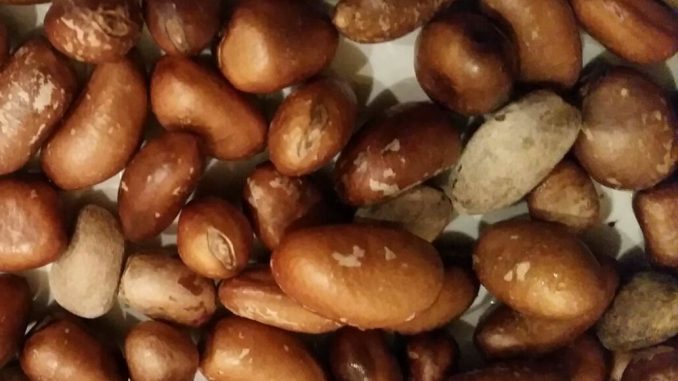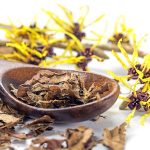
Calabash nutmeg (Monodora myristica Dunal) are dried seeds from a tropical forest tree found native in West Africa but also now grown in other parts of the planet. The species is in the same genus as mace and is used as an alternative being a little cheaper than its highly sought after cousin.
-like many spices has different names. You may have come across African or Jamaican nutmeg, or know it in a Nigerian tongue as airama, ehuru (Igbo), ariwo (Yoruba), iwo (Erhe), lubushi, ehiri or airama. Other names include Ehu and Muscadier de Calabash.
All parts of the tree seem to find some use. The wood is used for house building, joinery and fittings (Burkill, 1985; Okafor, 1987).
Description Of The Plant
The plant is a perennial in the Annonaceae, so it is in the same family as custard apples, soursops and cherimoya.
It is found in the forests of West Africa where it grows amongst various evergreens. (Burabai et al., 2007). It is grown commercially in Nigeria especially in the South, The Cameroons, Uganda, west Kenya and Nigeria and Liberia. The tree is also now found in the Carribean especially Jamaica but also South America.
The berry fruit is up to 20 cm in diameter, smooth, green and spherical. It grows woody when it reaches maturity. The berry is attached by a long stalk which is 60cm long.
The seeds are many, oblong and pale brown. They are surrounded by a whitish pulp. About 120 seeds can be extracted which are 1 inch long.
The seed is used like other nutmegs for the spiciness and fragrance that is lent to a range of foods. A Nigerian colleague who is Yoruba tells me that they use it in ragus, stews and some savoury soups. The seed has been successfully exploited in African traditional medicine over many years as are the barks and leaves for some applications.
Compounds In Calabash Nutmeg
The essential oil from the leaves contains β-caryophyllene, α-humulene and α-pinene. The seeds contain α-phellandrene, α-pinene, myrcene, limonene and pinene.
Culinary Uses For Calabash Nutmeg
The nutmeg is often in an extremely hard shell which is best removed by banging with a hammer. The seed is grated or ground. Again, my colleague has added it to a certain type of pepper soup but I’ve seen it in a number of baked goods especially cakes. As with all nutmegs, amounts used are sparing. Check out our recent article on its use in African spice mixes because it works so well with other pungent spices like ginger and alligator pepper.
It can be used in western style custard tarts where it offers a slightly different pungency. A Portuguese Custard tart for example certainly benefits from a dusting.
The nutmeg when ground must be treated carefully so that it is not contaminated with Aspergillus moulds such as A. flavi. This particular mould produces aflatoxins. The spice is prone to contamination and can often be sold with this fungus present (Ezekiel et al., 2012).
With soup, about a half teaspoon should do it to a gallon of broth!
Medicinal Uses
The stem bark is used to treat stomach conditions, fevers, eye disease and hemorrhoids (Uwakwe & Nwaoguikpe, 2008).
The seeds are used in the Central African Republic to treat headache and hypertension (Koudou et al., 2007). In some countries the seeds are used to repel fleas and lice. They are also used as a diuretic, as an anti-emetic (rather similar to ginger in many respects) and as a general tonic
Hypercholesterolemia is a risk factor for chronic heart disease, stroke and other cardiovascular related conditions. It is also associated with hyperlipidemia. A water extract of the dried fruits was shown in a rat model to reduce hypercholesterolaemia (Onyenibe et al., 2015).
References
Burabai, W., Akor, A.J., Igoni, A.H., Puyate, Y.T. (2007) Fracture resistance of African Nutmeg (Monodora myristica) compressive loading. Electron. J. Environ Agric Food Chem. 6(10) pp. 2434–2442 (Article)
Burkill, H.M. (1985) The useful plants of West Tropical Africa Vol. 1, Families of A-D Published by Royal Botanic Gardens, Kew, p 960.
Ezekiel, C. N., Fapohunda, S. O., Olorunfemi, M. F., Oyebanji, A. O., & Obi, I. (2013). Mycobiota and aflatoxin B1 contamination of Piper guineense (Ashanti pepper), P. nigrum L.(black pepper) and Monodora myristica (calabash nutmeg) from Lagos, Nigeria. International Food Research Journal, 20(1).
Koudou, J., Etou Ossibi, A.W., Aklikokou, K., Abenna, A.A., et al. (2007) Chemical composition and hypotensive effects of the essential oil of Monodora myristica Gaertn. J. Biol. Sci. 7 pp. 937–942 (Article)
Nguefack, J., Leth, V., Amvam, V., Zollo, P.H., et al. (2004) Evaluation of five essential oils from aromatic plants of Cameroon for controlling food spoilage and mycotoxin producing fungi. Int. J. Food Microbiol. 94(3) pp. 329–334
Okafor, J.C. (1987), Development of forest tree crops for food supplies in Nigeria, Forest Ecol. Man., 1, pp. 235-247
Onyenibe, N. S., Fowokemi, K. T., & Emmanuel, O. B. (2015). African Nutmeg (Monodora Myristica) Lowers Cholesterol and Modulates Lipid Peroxidation in Experimentally Induced Hypercholesterolemic Male Wistar Rats. International journal of biomedical science : IJBS, 11(2), pp. 86–92.
Uwakwe, A.A., Nwaoguikpe, R.N. (2008) In-vitro antisickling effects of Xylopia aethiopica and Monodora myristica . J. Med. Plant Res. 2(6) pp. 119–124
Revision. Addition of references, extra information on properties etc. on original article of 31st August, 2017.


I bought some of these in the USA. We use it in Liberia for pepper soups and goat stew. It is not available I like it used to be. I try to use regular nutmeg but it is not the same as it used to be with my mothers cooking. We call it Jamaican nutmeg as well because my aunt has tried to send me some in the past.
tell me where to buy this please !
Common seed yet powerful. Educative piece.
Thanks for the great info.
Never heard of this nut I’m going to be looking out for it. I assume its like ordinary nutmeg right?